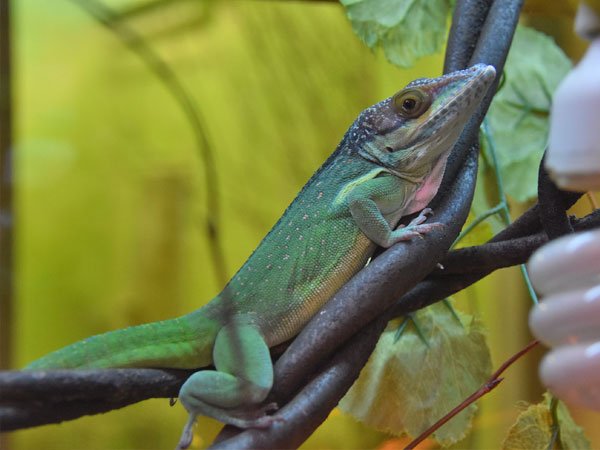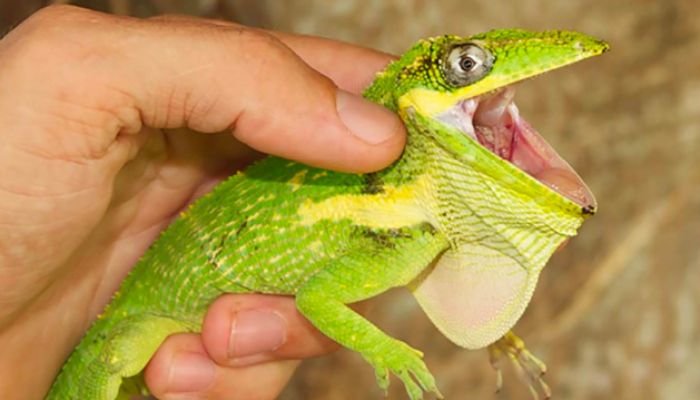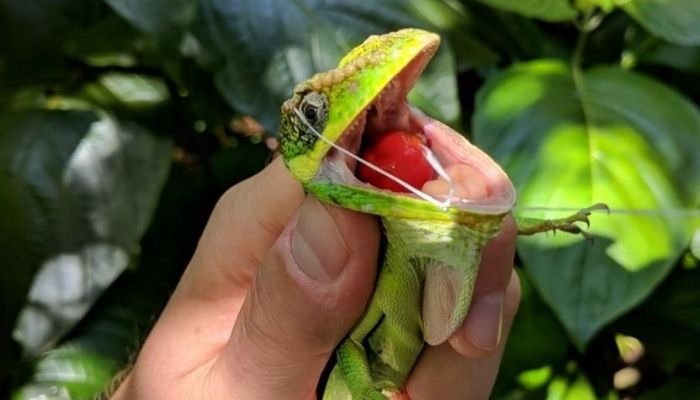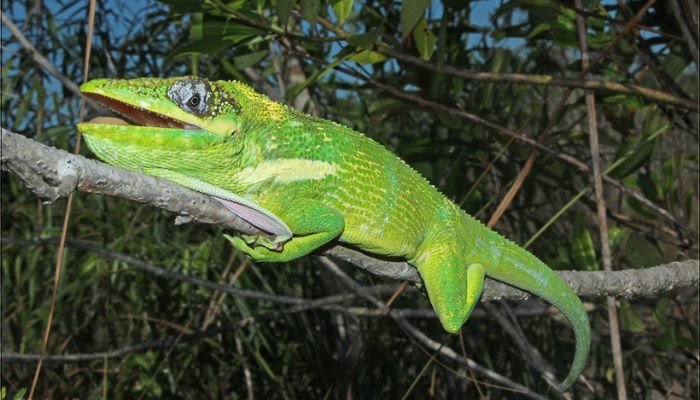
The Knight Anole is a large lizard species that is native to Cuba and the Cayman Islands. This species is also known as the Cuban Knight Anole and the Cuban Giant Anole. It is renowned for its sturdy construction, towering stature, and vibrant green hue. As arboreal animals, knight anoles spend a significant amount of time in trees. They are aggressive and exhibit dominance behaviors, such as head bobbing and dewlap extension, to designate their territory and attract mates. They are popular among reptile collectors and enthusiasts due to their striking appearance and distinct behavior.. Here are Knight anole Guide on Food, Habitat, Size, Lifespan & Predators below-
Knight Anole Stats in Table format
The stats are given below for Knight anole
| Reptiles List | Knight anole |
|---|---|
| Family | Polychrotidae |
| Type | Lizard |
| Size | Large |
| Length | Knight anole: Up to 14-20 inches (35-50 cm) |
| Color | Knight anole: The color varies depending on the age and mood, but knight anoles can change their color from shades of green to brown or gray. |
| Weight | Knight anole: Typically weighs between 5 to 10 ounces.. |
| Lifespan | 5-8 years (or more) |
| Reproduction | Oviparous, lays eggs |
| Gestation Periods | The gestation period for a Knight anole is approximately 6-8 weeks. |
| Endangered Status | Least Concern (IUCN Red List) |
| Features | Dewlap for communication, ability to change color |
| Country & Areas | Knight anoles are found in the Caribbean islands, specifically in countries such as Cuba, Jamaica, and the Cayman Islands. |
Knight Anole Natural Habitat and Distribution
The fascinating Knight Anole (Anolis equestris) is endemic to Cuba and other islands in the Caribbean. The best places to spot one of these anoles are in thick, tropical forests near a water supply. They like to live in the trees because of the warm, humid temperature and the fact that they are so easy to identify.
Knight Anole Physical Features and Adaptations
Here are some information about Knight Anole Physical Features and Adaptations
1. Body Structure
Male Knight Anoles can reach lengths of 20-50 inches, making them the largest of all anole species; females are slightly smaller. As they move through the trees, their long, lean bodies and well-developed tails help them maintain their equilibrium.
2. Coloration and Patterns
The Knight Anole’s vivid coloring stands out among other characteristics. They have a wide variety of eye-catching colors, from light green to dark emerald. They have the ability to subtly alter their appearance in response to their emotions or the surrounding environment.

3. Defense Mechanisms
Knight Anoles have a number of defense measures to ward off predators. When threatened, they can expand a pouch in their throat, giving the impression that they are much bigger and more powerful than they actually are. They can escape from a predator by cutting off their tail (a process called autotomy) and growing a new one over time.
Knight Anole Diet and Feeding Habits
Here are some information about Knight Anole Diet and Feeding Habits
1. Diet Type
The majority of Knight Anole’s diet is made up of insects. Their lengthy, sticky tongues allow them to hunt efficiently.
2. Preferred Food Sources
They mostly subsist on smaller insects like crickets, grasshoppers, mealworms, and the like. They have been known to eat small lizards and other reptiles on occasion.
3. Feeding Schedule
Knight Anoles are primarily active throughout the day because they are diurnal. They are diurnal hunters and feeders; providing them with food once or twice day will help guarantee they get the calories and nutrients they need to thrive.
Knight Anole Housing and Enclosure Requirements
Here are some information about Knight Anole Housing and Enclosure Requirements
1. Terrarium Size and Setup
The health and happiness of Knight Anoles depend on their access to ample space and enrichment. A single adult anole needs at least 30 liters of space, while numerous animals need even more room. Because of their arboreal lifestyle, they require ample vertical space in which to climb and sun themselves.
2. Substrate Options
Select a medium that retains moisture effectively, like coconut coir or cypress mulch. These substrates are better suited to the anoles since they retain moisture and look like the forest floor.
3. Temperature and Lighting
Knight Anoles need a heated basking area between 85 and 90 degrees Fahrenheit (29 and 32 degrees Celsius), and a colder area between 75 and 80 degrees Fahrenheit (24 and 27 degrees Celsius). Because it aids in calcium metabolism and protects against disorders caused by a lack of calcium, full-spectrum UVB lighting is crucial to their health.
4. Humidity and Water Needs
Knight Anoles require a humid environment because they are native to warm, wet climates. Maintain an enclosure humidity of 70–80% by spraying it frequently. If you want to help them stay healthy and comfortable, provide them access to a shallow water dish for drinking and soaking.
Knight Anole Behaviour and Temperament
Here are some information about Knight Anole Behaviour and Temperament
1. Activity Levels
As active reptiles go, Knight Anoles spend a lot of time in the air, on the ground, and in the water. Enthusiasts of reptiles may find great pleasure in witnessing their lively antics.

2. Social Behaviour
Knight Anoles may not be the most sociable of animals, but they may live together calmly in a large cage with plenty of places to hide and sun themselves. But it’s important to keep an eye on them to make sure no fighting breaks out.
3. Handling and Taming
In general, picking up a Knight Anole might cause the animal stress or perhaps cause it to become defensive. Minimizing handling and focusing on creating a lively and enriched enclosure environment is optimal.
Knight Anole Breeding and Reproduction
Knight Anole Breeding and Reproduction
1. Mating and Courtship Rituals
During mating season, males show off their dominance by flaunting their multicolored dewlaps in an effort to woo potential mates and stake claim to their area. There are elaborate displays and head bobbing included in the courtship ritual.
2. Incubation and Hatchlings
After mating, the ladies would go to secret spots in the enclosure to lay their eggs. In most cases, the female will abandon her nest and her eggs without providing any kind of care for them. Hatchlings are left to fend for themselves after an incubation phase that can last anywhere from 40-60 days.
Knight Anole Common Health Issues and Veterinary Care
Here are some information about Knight Anole Common Health Issues and Veterinary Care
1. Respiratory Infections
Knight Incorrect environmental conditions, such as high temperatures or low humidity, can lead to respiratory illnesses in anoles. Breathing through the mouth, wheezing, and fatigue are all symptoms of a respiratory problem. If you see any of these symptoms, get your pet to the vet right once.
2. Parasites:
Parasites, both internal and external, can negatively impact a Knight Anole’s health. Monitoring and treating parasite infestations requires routine fecal investigations and veterinary checkups.
3. Metabolic Bone Disease
Metabolic bone disease, characterized by bone weakness and abnormalities, can be triggered by a lack of ultraviolet B (UVB) light and a lack of calcium in the diet. Preventing this disease requires a balanced diet high in calcium and enough lighting.

Importance of Regular Vet Check-ups
To ensure the health and well-being of Knight Anoles, routine veterinarian examinations are essential. A trained reptile vet can check the animal over thoroughly, treat any problems they find, and advise you on how to best care for your reptile. Successful treatment and a longer, healthier life span are greatly enhanced by early diagnosis of health problems in these fascinating reptiles.
Conclusion:
Care for a Knight Anole is exciting because of the reptile’s remarkable colors and temperament. In order to provide them with a proper environment in captivity, it is essential to have a firm grasp on their native habitat, physical traits, food needs, and behavior. Reptile keepers can take pleasure in the companionship of these beautiful lizards for the whole of their lives by providing a suitable habitat and adhering to the lizards’ unique care needs. The long-term success of maintaining Knight Anoles as fascinating pets relies on regular veterinary checkups for early diagnosis and avoidance of health disorders.
FAQs
Q: What is the family and Type of a Knight anole?
A: The Knight anole is a species of family Polychrotidae. The Famous Knight anole is a member of the family Lizard.
Q: What is the average size of a Knight anole?
A: The average adult Knight anole is Large between Knight anole: Up to 14-20 inches (35-50 cm).
Q: How long can a Knight anole grow in size in lengths?
A: Knight anole is Large in size and The Knight anole is a reptile that can grow up to 14-20 inches (35-50 cm) in length.
Q: What colors do Knight anole come in?
The knight anole, a fascinating reptile, is capable of undergoing a color shift. The knight anole’s coloration shifts with age and temperament. It can be a variety of colors of green, from bright to muted. The knight anole’s ability to change color is one of its distinguishing features and makes it a fascinating animal to study.
Q: How big can a Knight anole get in weight?
A: The Knight anole, a type of lizard, usually has a weight ranging from 5 to 10 ounces.
Q: What are the special Features of a Knight anole?
A: Knight anole are Dewlap for communication, ability to change color
Q: How long do Knight anole live?
A: The usual lifespan of an Knight anole is The Knight anole, also known as the Cuban knight anole, has a lifespan of 5-8 years or even longer.
Q: What food does the Knight anole eat?
Insects like crickets, roaches, and mealworms make up the bulk of the Knight anole’s diet. Small vertebrates, such as lizards and frogs, may also be consumed. Fruits, vegetables, and commercial reptile food are all acceptable options for captive diets. To ensure their health and happiness, a nutritious food should be provided.
Q: What is the best habitat for a Knight anole?
The tropical rainforest provides the perfect environment for Knight anoles. Originally discovered in the Caribbean, the ideal climate for these arboreal reptiles is hot and humid. They require a sizable enclosure with high walls for climbing and basking. The habitat would look more natural if it were densely planted with a large variety of actual plants. Optimal conditions include daytime highs of around 80 F (27 C), with a slight drop to around 27 F (29 C) at night. Vitamin D production and calcium metabolism both require exposure to UVB radiation. A misting system, or steady spraying, would help maintain high humidity levels in the cage. Having access to clean water for personal hygiene is a necessity. Maintaining a Knight anole’s ideal temperature, humidity, and cleanliness is essential to the animal’s survival.
Q: How do Knight Anole give birth?
A: Knight anole are Oviparous, lays eggs
Q: How long is the gestation period for a Knight anole?
A: The gestation period of a Knight anole is approximately The gestation period for a Knight anole is approximately 6-8 weeks.
Q: What is the natural behavior of a Knight anole?
Most Knight anoles, or A, are The Knight anole, also called the Cuban knight anole, is largely an arboreal animal in its natural habitat. The green coloring of these lizards is a trademark of their native Cuba. They prefer to remain in the trees, where they can better see their prey, and where they spend the most of their time. Male knight anoles are very protective of their area and will fight off any intruders. They are very hostile, often resorting to head-bobbing displays of dominance. In order to maintain a constant body temperature, these lizards have been seen basking in the sun during the day. The intriguing actions of knight anoles are a result of their arboreal lifestyle.
Q: Is the Knight anole endangered?
A: The Knight anole is Least Concern (IUCN Red List).
Q: What are the prey of Knight Anole?
Insects like crickets, grasshoppers, and beetles are some of the Knight anole’s favorite meals. They also prey on amphibians, reptiles, and birds of a similar size. They may also eat spiders and other insects and crustaceans. The Knight anole is a scavenger that will devour anything small enough to fit in its beak.
Q: Do Knight Anole have any Predators?
Answer: (Knight) Anole has Predators of the Knight anole include larger lizards and snakes, as well as birds of prey like hawks and owls. The Knight anole is an easy prey because to its huge size and bright colors, which attract these predators. It’s possible that young and defenseless Knight anoles fall prey to rats and mice and other small mammals.
Q: How Fast Does Knight Anole Move?
A: The Knight Anole can move at speeds of up to 20 miles per hour.
Q. What is Bite Force of Knight anole in PSI?
A. Bite Force in PSI for a Knight anole is not available as it is not a commonly measured metric for this species.
Q: Can we keep Knight Anole as pets?
Knight anoles can be tamed and made into pets. They are a lizard species that thrives in captivity, drawing attention with its eye-catching patterns and antics. While they might make fascinating pets, it’s vital to do your homework before deciding to bring one home.
Q. Are Knight Anole venomous?
There is no poison in the venom of a Knight Anole (Anolis equestris). Large and brightly colored as they are, these lizards lack venom glands and produce no poisonous compounds despite their reputation for aggressive territorial behavior. Their quickness and dexterity are crucial for hunting and protecting themselves from enemies.
Q. Are Knight Anole good for pest control?
The Knight Anole is an opportunistic insectivore, meaning that insects make up the bulk of its diet. This means they have the potential to help regulate insect populations in their natural environment. Insects, such as crickets, grasshoppers, spiders, and other small arthropods, may be consumed by them. However, the size of the local Knight Anole population and the specific pest population would largely determine how efficient they are as pest controllers.
Keep in mind that eradicating pests by importing non-native species (like Knight Anoles) can have unforeseen repercussions, like as upsetting the delicate balance of the environment. Therefore, if they are not native to the area, it is not advised to introduce them purely for the purpose of pest management.
Q. Do Knight Anole require a UVB light source?
Knight Anoles, like many other reptiles, need exposure to UVB light to stay healthy. The absorption of calcium and maintenance of healthy bones depend on vitamin D3, which is synthesized in the skin in response to UVB light. They require a UVB light source to simulate the sunshine they would be exposed to in the wild while kept in captivity.
In addition to the right amount of heat and humidity, a UVB lamp arrangement is essential for the health of your pet Knight Anole. If you want to give your Knight Anole the best possible home, talking to a reptile vet or an experienced herpetologist will assist.
I hope you like reading on Knight anole FAQ Guide on Food, Habitat, Size, Lifespan and Predators.
